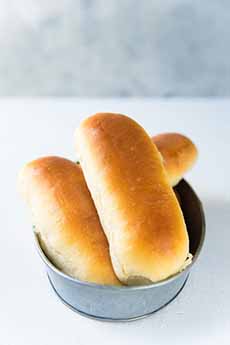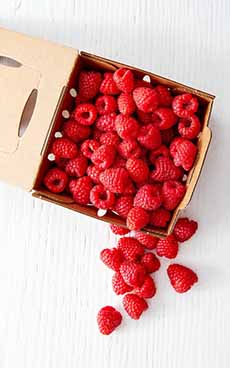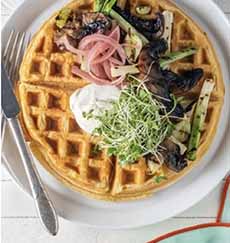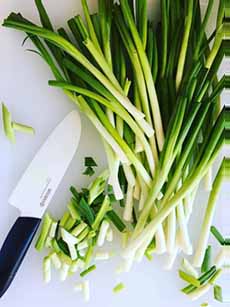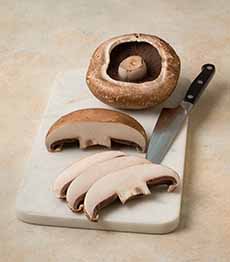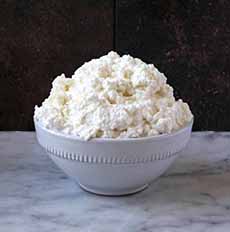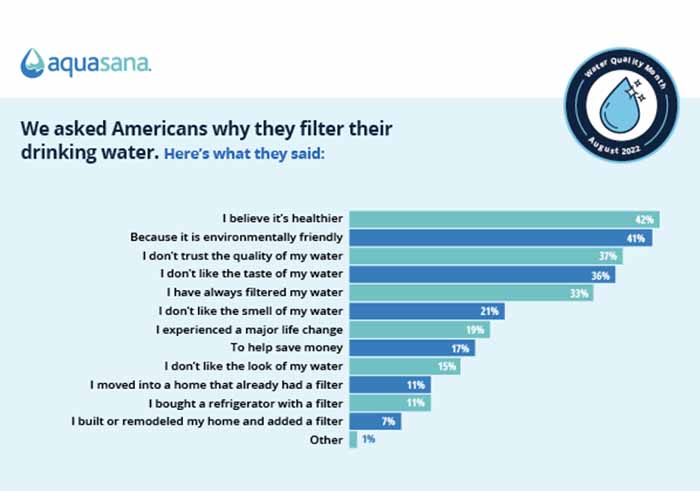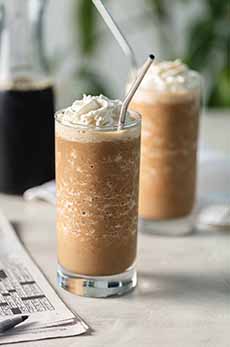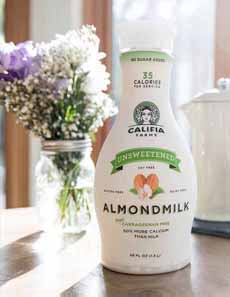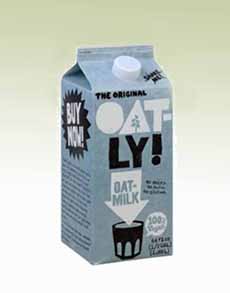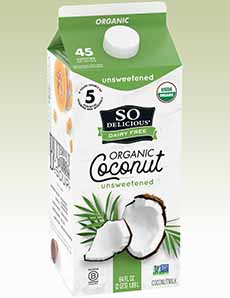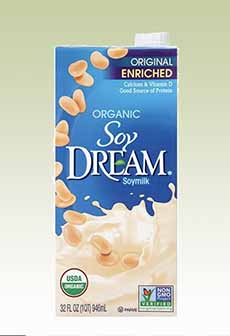|

[1] Chocolate pot de crème, a French chocolate custard (photo © Volpi Foods).
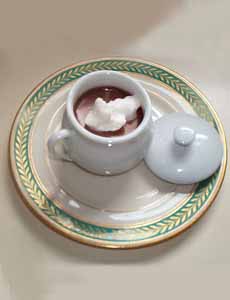
[2] Chocolate pot de crème in a French pot de crème dish with a chantilly (whipped cream)(photo © Seduction Meals).
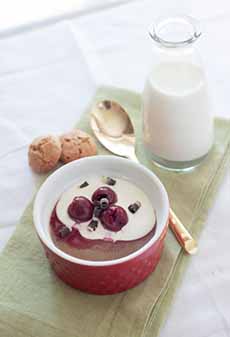
[3] Chocolate pot de creme with modern garnishes: raspberries, cacao nibs, chantilly, and a side of amaretti (photo © World Market).
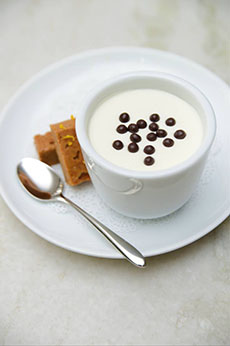
[4] White chocolate pot de creme with a garnish of mini chocolate chips and a side of petite cookies (photo © Fig & Olive | Facebook).

[5] Raspberry pot de crème. Here’s the recipe (photo © Driscoll’s).
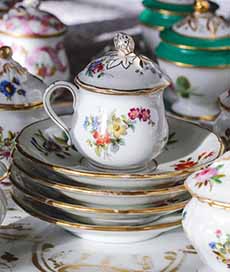
[6] (photo © Tanya L. Cooper | The Cottage Journal).

[7] Pumpkin pot de crème with maple chantilly (whipped cream) and candied hazelnuts (photo © Kindred Restaurant | Davidson, North Carolina)
|
|
August 27th is National Pots de Crème Day, one of the three classic French baked custards (pronounced poe-duh-CREM, meaning pot of cream). All three are made of eggs, milk and/or cream, and sugar (in different proportions), along with a flavoring such as vanilla.
Julia Child’s Chocolate Pots de Crème recipe is below, but first, a bit more about pots de crème:
These silky, baked French custards have been delighting diners since they first appeared on the dinner table.
Crème brûlée is made of all heavy cream and egg yolks and is topped with a brittle layer of caramelized sugar (brûlée is French for burnt, crème brûlée means “burnt custard”). It is the thickest of the three.
Crème caramel (called flan in Spanish) is the lightest of the three, made with whole eggs and a blend of milk and cream.
Pot de crème (plural, pots de crème) is made from equal parts of cream and milk and an extensive amount of egg yolks—e.g., 6 yolks per 2 cups of cream/milk, which make it a softer custard. Its consistency falls between the first two.
The French do not have a general word for custard, and “crème” is the word for cream—whether referring to a preparation made with cream, or the ingredient itself. The traditional egg-thickened baked custard is crème moulée.
Pot de crème, a 16th-century dessert became so popular that by the 17th century, dedicated porcelain cups—also called pots de crème or petits pots (petite, or small, pots) were made to serve them (photos #2 and #6).
There’s more about the history of pot de crème below.
Today few of us have space for a set of pot de crème cups, but you can easily serve pots de crème in:
Custard cups, small glass bowls (photo #5), small pedestal glasses, or other dessert dishes
Demitasse cups or small porcelain tea cups
Porcelain ramekins (photos #3, #4, and #7
Small mason jars
Small wine glasses or rocks glasses
A recipe for Julia Child’s chocolate pots de crème follows. Pots de crème can be made in just about any dessert flavor you can name, but for nostalgia’s sake, this was the first pots de crème recipe we made, long ago.
> The Different Types Of Custard
> Key Lime Pots De Crème Recipe
RECIPE: JULIA CHILD’S PETITS POTS DE CRÈME AU CHOCOLATE
This is a variation of Julia Child’s recipe from The French Cookbook. She translated the recipe name as Chocolate Cream Custards.
This recipe makes four 1/2 cup ramekins or chocolate pots. You might consider doubling the recipe: It’s not worth the effort for four little ramekins.
Instead of Jamaican rum, you can substitute orange liqueur or coffee liqueur. Instead of whipped cream, consider a dab of mascarpone or crème fraîche.
While Julia used only the classic French pots de crème garnish of chantilly, other garnishes we enjoy include candied orange peel, chocolate-covered espresso beans, and shaved or grated white chocolate.
If you like the combination of sweet and salty, try a sprinkle of crunchy coarse sea salt. You can also place a raspberry and a small mint leaf next to the chantilly.
When Julia published her cookbooks, artisan chocolate was not well known in the U.S. She used supermarket brands. However, the better the chocolate you use, the even more delicious the pots de crème will be.
Ingredients
2/3 cup semisweet chocolate bits, or four ounces (4 squares) semisweet baking chocolate
1 cup light cream
Optional: 2 to 3 tablespoons sugar
1 large egg plus 2 egg yolks
1-1/2 tablespoons dark Jamaican rum
Optional for serving: chantilly (whipped cream)
Preparation
1. PLACE a rack on the lower third of the oven, and preheat to 350°F.
2. PLACE the chocolate in a quart measuring cup (or equivalent) and add enough cream to reach the 1-1/2 cup mark. Pour the mixture into a saucepan and set over low heat, stirring occasionally until the chocolate has completely melted. Stir in the sugar.
3. ADD the egg and yolks to a bowl, and whisk just enough to blend. In a thin stream, gradually pour the egg mixture into the hot chocolate mixture, continuing to stir the chocolate mixture. Add the rum.
4. DIVIDE the mixture among the ramekins and place them in a baking dish. Tamp down any air bubbles on the surface of the chocolate mixture.
5. FILL the baking dish with water up to 2/3 the height of the ramekins. Place the ramekins in the baking dish. Cover the baking dish with aluminum foil to prevent a crust from forming on the custard.
6. PLACE the dish on the lower rack of the oven for about 20 minutes. The custards are done when they puff into slight domes but still quiver a bit. A toothpick stuck in the center should be slightly wet but not runny.
You can eat the custards hot or warm from the oven, or refrigerate them for 30 minutes or longer. They will keep in the fridge, individually covered with plastic wrap after they chill down, for up to five days.
POTS DE CRÈME HISTORY
Custards date back to the Middle Ages and were used as fillings for pies and tarts. In fact, the word custard derives from the French “croustade,” which is a tart with a crust.
Similarly, pots de crème were originally custard fillings for pies, appearing sometime in the 17th century.
At some point, some observant cook or assistant decided to bake the filling alone, in individual small cups. A small cup with a lid and one handle evolved specifically for pots de crème (photos #2 and #6).
The dessert also became known as petit pots, little pots.
After the 16th century, custards began to be made in individual dishes, typically in chocolate*, fruit, and vanilla flavors.
While today chocolate pots de crème are most often seen on restaurant menus, we see any and all dessert flavors: butterscotch, caramel, coffee, matcha, passionfruit, pumpkin, raspberry, and whatever is trending at the moment.
Pots De Crème Cups
Small porcelain cups (about three inches tall) with lids topped with finials, were in use by the 18th century, and these pots de crème cups were used on formal tables in both Europe and the U.S.
The small size of the cup dictated that the custard be eaten with a demitasse spoon.
You can buy pots de crème cups today, in both modern porcelain and antique sets. The latter usually included a footed porcelain tray, or even a three-tiered tray, on which the cups were brought to the table.
Styles, patterns, and colors vary widely; from fairly rustic to elegant and gold-enhanced.
From the mid-1700s to the early 1900s, some of the finest examples came from prestige porcelain houses such as Meissen, Sèvres, Wedgwood, and Worcester.
As an example of how elaborate dinnerware was for the well-to-do—think of all the different forks, knives, and spoons with which those tables were set:
Cups of a similar size were used for both pots de crème and hot chocolate. But the chocolate cups typically had two handles! [source]
Today, serve your pots de crème in whatever cups, dishes, or glasses you have. Your family and friends will be just as happy whatever the container.
|








